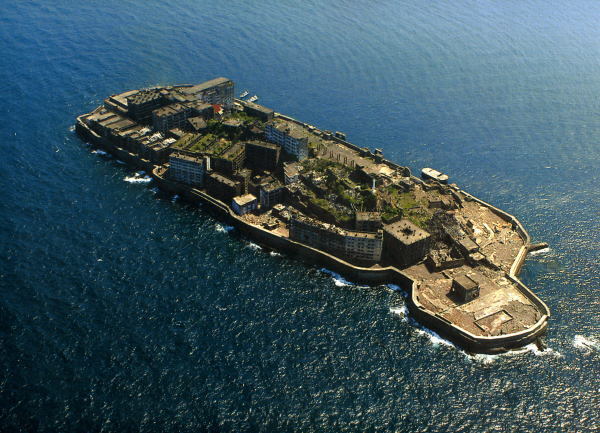[Newsmaker] Hidden truth behind Japan’s world heritage site -- Hashima Island
By Park Han-naPublished : June 18, 2020 - 17:12

For Japanese, Hashima Island may be a site that evokes pride that propelled the country to the global stage as an economic powerhouse.
However, Koreans consider the islet off the coast of Nagasaki, also called Battleship Island, as a tragic place where hundreds of victims of forced labor suffered wrenching hardships in the undersea coal mines.
It was listed as UNESCO World Heritage Sites in 2015 along with other 22 sites of Japan’s Meiji Industrial Revolution. The problem for Korea is that some 33,400 citizens were drafted to work at mines, foundries and shipyards at seven of the sites.
Some 500 to 800 Koreans were taken for forced labor during Tokyo’s 1910-45 colonial rule to a coal mine underneath Hashima Island, bought by the Mitsubishi Group in 1890 to provide fuel for the country’s shipbuilding industry.
When mines were fully operational, some 5,300 people lived in the small 6.3-hectare artificial reclaimed island. Japanese miners and company employees resided in high-rise apartment buildings while Korean laborers stayed in shabby sites with iron bars across the windows.
There was a 10-meter tall watchtower to police workers who attempted to escape from poor working conditions and brutal violence. Failed attempts ended up in Davy Jones’ Locker, according to testimonies by survivors.
The dark and hidden chapter of Japan’s history began to unfold with a 1983 testimony by Seo Jung-woo who was conscripted for forced work at the age of 14. He passed away in 2001.
“Among my colleagues, about 40 people drowned while trying to break out from the island or committed suicide.” Seo said.
Miners headed down before sunrise and returned 12 hours later from the heating surface of the underwater mine that hits over 40 degrees Celsius.
Due to the height of the mine, miners had to virtually lie down to excavate coals with the ceiling about 50 centimeters above their nose.
“There was a small island next to Hashima. It’s called a ‘crematory’ as people who died while working or escaping from Hashima were cremated there,” survivor Lee In-woo said in an interview with Yonhap News Agency back in 2017.
At least 50 Korean workers were reported to have been cremated on Nakanoshima Island. More than half of them were killed by accidents in the Hashima coal mine and other deaths were caused by suffocation, trauma, crushing and drowning, according to documents related to cremations there.
To fend off Seoul’s initial stiff opposition against Japan’s UNESCO bid in 2015 for the designation of the island and other wartime industrial sites, Japanese representative stated at a formal World Heritage Committee session at that time: “Japan is prepared to take measures that allow an understanding that there were a large number of Koreans and others who were brought against their will and forced to work under harsh conditions in the 1940s at some of the sites.”
Japan also vowed to ensure the victims are remembered by establishing an information center.
The recent opening of the Industrial Heritage Information Center in Tokyo, which introduces the 23 Meiji-era sites, prompted fury here as Japan reneged on its promise to honor wartime forced labor victims through the content of exhibitions.
The walls of the center were filled with materials boasting its rapid industrialization and distorting the forced labor that publicized the testimony of about 30 residents who denied Japan’s crimes against humanity.
Displaying a pay envelope that was given to a Korean worker and a copy of the 1965 basic treaty between the two countries in which wartime employers of forced laborers insist that all compensation and reparation demands were settled under the pact appear to be aimed at whitewashing history.
The flip-flop seems to be a part of Japan’s strategy to counter a Korean court’s decision on June 4 to kick off the process of liquidating seized local assets of Japanese steelmaker Nippon Steel that committed World War II-era forced labor to compensate victims.
“Japan appears to be clarifying its position that there was no forced labor at the center because once it admits the fact then it could create grounds for legal liability,” Lee Won-deog, a professor of Japanese studies in Kookmin University told The Korea Herald.
By Park Han-na (hnpark@heraldcorp.com)









![[Kim Seong-kon] Democracy and the future of South Korea](http://res.heraldm.com/phpwas/restmb_idxmake.php?idx=644&simg=/content/image/2024/04/16/20240416050802_0.jpg&u=)








![[KH Explains] Hyundai's full hybrid edge to pay off amid slow transition to pure EVs](http://res.heraldm.com/phpwas/restmb_idxmake.php?idx=652&simg=/content/image/2024/04/18/20240418050645_0.jpg&u=20240418181020)

![[Today’s K-pop] Zico drops snippet of collaboration with Jennie](http://res.heraldm.com/phpwas/restmb_idxmake.php?idx=642&simg=/content/image/2024/04/18/20240418050702_0.jpg&u=)